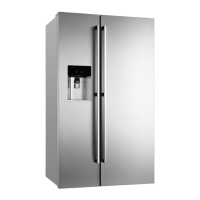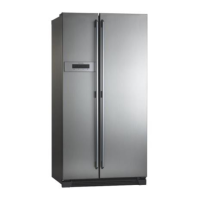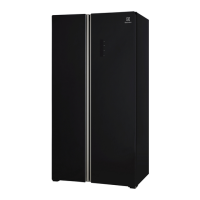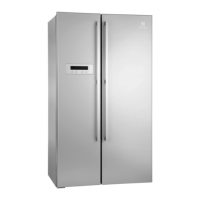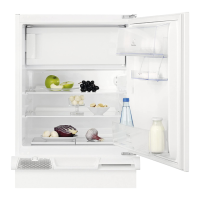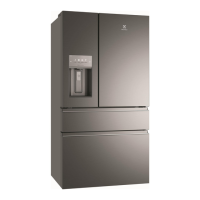Do you have a question about the Electrolux ESE6077 and is the answer not in the manual?
Explains symbols used in the manual for warnings, cautions, tips, and environmental advice.
Specifies intended household and similar applications for the appliance.
Critical safety guidelines for operating the appliance, including warnings for specific hazards.
Details safety precautions related to flammable R600a refrigerant used in the appliance.
Provides advice on recycling packing materials and safe disposal of the appliance.
Lists essential 'do' and 'do not' guidelines for safe and proper use of the refrigerator.
Highlights specific warnings for models equipped with ice and water dispensing features.
Illustrates and labels the standard features of the ESE6107 model refrigerator.
Illustrates and labels the features of the ESE6977 model with ice and water capabilities.
Illustrates and labels the standard features of the ESE7007 model refrigerator.
Illustrates and labels the features of the ESE6077 model with ice and water capabilities.
Specifies required air circulation clearances around the refrigerator for optimal performance.
Details how to adjust the refrigerator doors for proper alignment and self-closing.
Instructions for removing internal packaging materials before initial use.
Introduces the external water filter kit and installation requirements.
Step-by-step instructions for connecting the water supply and filter to the ice maker.
Detailed steps for connecting the water tubes to the filter and refrigerator.
Provides tips and useful information for operating the water dispenser after installation.
Describes the initial operation of the refrigerator and freezer after setup.
Explains common operational noises and their normality.
Details the function of temperature sensors and how to manage related alarms.
Explains the different energy-saving modes available for the refrigerator.
Offers advice for resolving display malfunctions, often related to power interruptions.
Instructions on how to adjust and remove refrigerator door storage bins.
Describes the coin-lockable compartment and its operation.
Explains the purpose and benefits of the dairy compartment for storing butter and cheese.
Guides on using crisper bins for vegetables and fruits, including humidity control.
Details how to use the bottle twist holder for secure bottle storage.
Explains the use of the bottle caddy for storing bottles like wine or beer.
Describes how to collapse and reposition the slide-away glass shelf.
Instructions for removing and refitting freezer baskets for cleaning and access.
Explains the role of the deodoriser in removing internal food odours.
Instructions for using the twist ice & serve mechanism to dispense ice cubes.
Guides on operating the ice and water dispenser for cool water and different ice types.
Details how to use the bottle filling function for efficient dispensing into bottles.
How to use the fast freeze function to quickly freeze food in the freezer compartment.
Explains the freezer temperature alarm and how to respond to it.
Information on the door alarm function and how to activate/deactivate the child lock.
Instructions for using the timer to quickly chill beverages in the freezer.
Explains Normal, Eco, and Vacation modes for energy saving.
How to activate Vacation mode for extended periods away from the appliance.
Step-by-step guide to adjust refrigerator and freezer temperatures.
How to activate the fast ice function to increase ice production speed.
Explains door open alarms, indicators, and muting the alarm.
How to turn the ice maker off and indicators for ice bin presence.
Procedures for silencing and resetting the freezer temperature alarm.
How to check and reset the water filter status indicator.
Guide to adjusting ice cube size based on water pressure.
How to select between cubed and crushed ice from the dispenser.
Details on how the water dispenser works, including flushing and cooling.
Explains how the ice maker and dispenser work, including initial ice production.
Step-by-step guide for cleaning the ice dispenser and its container.
Instructions for managing the ice storage bin, especially after power failure or infrequent use.
Detailed steps for replacing the external water filter and flushing the system.
Notes regarding the long-life LED lighting and service if it fails.
Guidelines for regularly cleaning the interior surfaces and parts of the refrigerator.
Advice on keeping door seals clean to ensure proper closure and prevent damage.
Tips and advice to help reduce the refrigerator's running costs and energy usage.
Recommendations for optimal food storage in the refrigerator and freezer.
Guidance on selecting, preparing, and freezing food for later use.
Safety advice for users, including child supervision and handling of the appliance.
Instructions for switching off the appliance for extended periods and during power failures.
Checks to perform if the refrigerator is not operating or cooling correctly.
Explains common operational noises and potential causes for concern.
Tips for identifying and eliminating unpleasant odors within the refrigerator.
Reasons why the motor might run more than expected and how to minimize it.
Solutions for when the refrigerator is too warm or too cold.
Troubleshooting steps for heavy frosting in the freezer and water dripping issues.
Addresses problems with the electronic display not responding or doors opening unexpectedly.
Solutions for problems with the automatic ice maker not producing ice or producing too little.
Troubleshooting for the ice dispenser not dispensing, ice being jammed, or cubes being too small.
Addresses water leaks from the dispenser and the flap not closing properly.
Outlines the terms, conditions, and exclusions of the Electrolux product warranty.
Details the steps required to make a claim under the product warranty.
Provides contact information for service, spare parts, and customer care in Australia and New Zealand.
Explains symbols used in the manual for warnings, cautions, tips, and environmental advice.
Specifies intended household and similar applications for the appliance.
Critical safety guidelines for operating the appliance, including warnings for specific hazards.
Details safety precautions related to flammable R600a refrigerant used in the appliance.
Provides advice on recycling packing materials and safe disposal of the appliance.
Lists essential 'do' and 'do not' guidelines for safe and proper use of the refrigerator.
Highlights specific warnings for models equipped with ice and water dispensing features.
Illustrates and labels the standard features of the ESE6107 model refrigerator.
Illustrates and labels the features of the ESE6977 model with ice and water capabilities.
Illustrates and labels the standard features of the ESE7007 model refrigerator.
Illustrates and labels the features of the ESE6077 model with ice and water capabilities.
Specifies required air circulation clearances around the refrigerator for optimal performance.
Details how to adjust the refrigerator doors for proper alignment and self-closing.
Instructions for removing internal packaging materials before initial use.
Introduces the external water filter kit and installation requirements.
Step-by-step instructions for connecting the water supply and filter to the ice maker.
Detailed steps for connecting the water tubes to the filter and refrigerator.
Provides tips and useful information for operating the water dispenser after installation.
Describes the initial operation of the refrigerator and freezer after setup.
Explains common operational noises and their normality.
Details the function of temperature sensors and how to manage related alarms.
Explains the different energy-saving modes available for the refrigerator.
Offers advice for resolving display malfunctions, often related to power interruptions.
Instructions on how to adjust and remove refrigerator door storage bins.
Describes the coin-lockable compartment and its operation.
Explains the purpose and benefits of the dairy compartment for storing butter and cheese.
Guides on using crisper bins for vegetables and fruits, including humidity control.
Details how to use the bottle twist holder for secure bottle storage.
Explains the use of the bottle caddy for storing bottles like wine or beer.
Describes how to collapse and reposition the slide-away glass shelf.
Instructions for removing and refitting freezer baskets for cleaning and access.
Explains the role of the deodoriser in removing internal food odours.
Instructions for using the twist ice & serve mechanism to dispense ice cubes.
Guides on operating the ice and water dispenser for cool water and different ice types.
Details how to use the bottle filling function for efficient dispensing into bottles.
How to use the fast freeze function to quickly freeze food in the freezer compartment.
Explains the freezer temperature alarm and how to respond to it.
Information on the door alarm function and how to activate/deactivate the child lock.
Instructions for using the timer to quickly chill beverages in the freezer.
Explains Normal, Eco, and Vacation modes for energy saving.
How to activate Vacation mode for extended periods away from the appliance.
Step-by-step guide to adjust refrigerator and freezer temperatures.
How to activate the fast ice function to increase ice production speed.
Explains door open alarms, indicators, and muting the alarm.
How to turn the ice maker off and indicators for ice bin presence.
Procedures for silencing and resetting the freezer temperature alarm.
How to check and reset the water filter status indicator.
Guide to adjusting ice cube size based on water pressure.
How to select between cubed and crushed ice from the dispenser.
Details on how the water dispenser works, including flushing and cooling.
Explains how the ice maker and dispenser work, including initial ice production.
Step-by-step guide for cleaning the ice dispenser and its container.
Instructions for managing the ice storage bin, especially after power failure or infrequent use.
Detailed steps for replacing the external water filter and flushing the system.
Notes regarding the long-life LED lighting and service if it fails.
Guidelines for regularly cleaning the interior surfaces and parts of the refrigerator.
Advice on keeping door seals clean to ensure proper closure and prevent damage.
Tips and advice to help reduce the refrigerator's running costs and energy usage.
Recommendations for optimal food storage in the refrigerator and freezer.
Guidance on selecting, preparing, and freezing food for later use.
Safety advice for users, including child supervision and handling of the appliance.
Instructions for switching off the appliance for extended periods and during power failures.
Checks to perform if the refrigerator is not operating or cooling correctly.
Explains common operational noises and potential causes for concern.
Tips for identifying and eliminating unpleasant odors within the refrigerator.
Reasons why the motor might run more than expected and how to minimize it.
Solutions for when the refrigerator is too warm or too cold.
Troubleshooting steps for heavy frosting in the freezer and water dripping issues.
Addresses problems with the electronic display not responding or doors opening unexpectedly.
Solutions for problems with the automatic ice maker not producing ice or producing too little.
Troubleshooting for the ice dispenser not dispensing, ice being jammed, or cubes being too small.
Addresses water leaks from the dispenser and the flap not closing properly.
Outlines the terms, conditions, and exclusions of the Electrolux product warranty.
Details the steps required to make a claim under the product warranty.
Provides contact information for service, spare parts, and customer care in Australia and New Zealand.
| Brand | Electrolux |
|---|---|
| Model | ESE6077 |
| Category | Refrigerator |
| Language | English |
